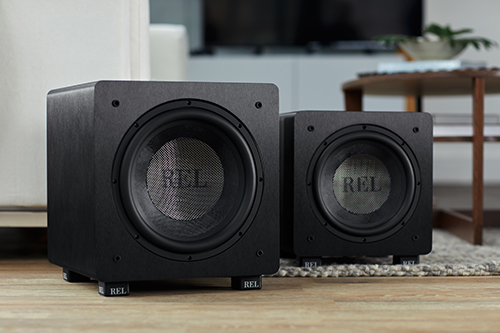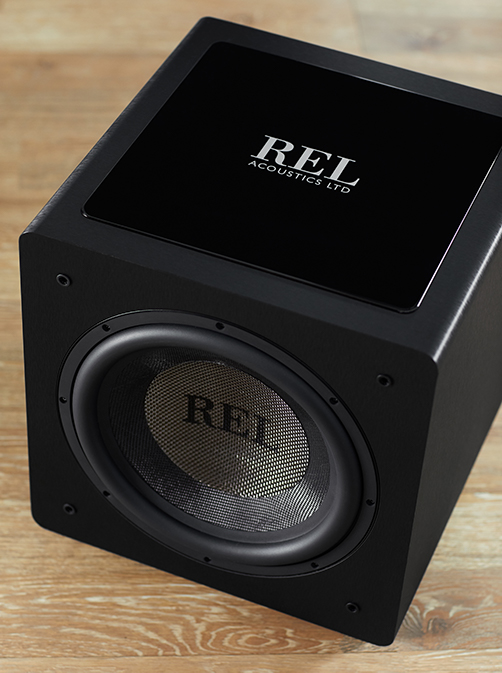Blog
Shaken and Stirred
Announcing REL’s Powerful New Serie HT Pure Theater Designs
 Shaken and stirred by the sheer dynamics of these brilliant new designs is what comes to mind when describing the sound we have just experienced as Justin and I are busy putting finishing touches on the max level tests. We run these tests to fine-tune our limiters so that the explosions that rock your theater don’t do damage to your new Serie HT Subs.
Shaken and stirred by the sheer dynamics of these brilliant new designs is what comes to mind when describing the sound we have just experienced as Justin and I are busy putting finishing touches on the max level tests. We run these tests to fine-tune our limiters so that the explosions that rock your theater don’t do damage to your new Serie HT Subs.
Wait, there’s no such thing as an HT series in REL’s lineup?! There is now and it’s set to rock your world. Devastating. Explosive. Carnage Inducing.
HT, short for Home Theater, is the equivalent of a precision-guided munition set to impact on the home theater world. Whereas every previous generation of RELs have been brilliant all-around performers, HT has one very narrow focus objective. Power theater.
“We needed to revisit the entire premise around home theater and how we can best accomplish the needs of many customers. Our theater customers need access to ruggedly reliable, truly affordable, high value subwoofers for pure theatre use”, said John Hunter, REL’s Head of Design and Acoustics at the outset of this project. “And they need to play seriously loud for that customer to take notice. Can’t cost an arm and a leg either, has to be something that a young family can afford.” Thus was born Serie HT.
To accomplish this, we had to set aside a few of our common priorities because for those that need a subwoofer principally for power theater usage (as opposed to a more balanced usage that prioritizes music and movie performance, as do all current RELs) the design goals change fairly radically. Much of what is difficult to do in subwoofers; leading edge attack, the ability to render hall decay patterns such that the music and its surroundings exist in separate dimensions, perfect seamless blending of sub and main speaker such that a REL simply renders the current system into a full range, vastly more dynamic and competent version of itself need not apply for theater use. And this saves money.
Why? Because a .1/LFE signal is a world unto itself, untethered to reality and the aural maps of real sonic events we all build up over a lifetime of experiences. Theater often deals with the world of the fantastic, of generating sonic impressions of sounds we have never experienced and in some cases, hope never to have to do so (speaking personally, I have no need to ever experience the glottal breathing of the Alien up close and Sigourney-Weaver-personal). Many of the finest sonic effects ever generated, intended to convince us that something we have never before seen is taking place in three-dimensional aural reality in our living rooms or home theaters, are the projected imaginations of those brilliant sound engineers.[1]
Instead, what takes sonic precedence is sheer visceral attack and punishing volumes. Here, REL has a massive advantage because it is the “attack”, the leading-edge transients that often create the sense of panic. When a grenade explodes nearby onscreen, the first initial crack is what makes one’s eyes involuntarily close, immediately confirmed by the WHUMP of the actual explosion as the room turns deafeningly loud. Folks, we do F-A-S-T better than anyone else in the world of sub-bass. That grenade played through a REL will have you diving under the ottoman for cover (“Honey, why the hell did we buy such a small ottoman?”).

Speed Kills: To deliver an experience beyond the slow, heavy ponderous qualities of the average affordable sub, our engineers experimented with a variety of solutions before landing on a high-tech composite of carbon and glass fibre that produces startling initial dynamics capable of taking theatre sound to a new dimension. Common, pedestrian theatre bass often takes on a dull, rhythmic quality annoying for the sameness it imposes on scene after scene. Whereas with the new REL HT, each scene takes on a freshness of pace and character that matches precisely the visuals on screen. One recent listener likened it to how an old film that has been cleaned up, restored and re-colored can transform it into a new experience. Speed matters in all types of bass reproduction
It’s a Size Thing: Power and size matters much more than it does in well rounded, multi-purpose subs. So we selected a 12” CarbonGlas™ driver for our HT/1205 model with long travel able to handle all that our new 500 Watt amplifier can dish out. It’s a matter of simple math, a 12” driver moving just ½” (12mm) will play much louder than an 8” driver travelling over 1” (25mm). We wanted these to be dominant in their category, and do so at the same or lower prices than the competition. We feel confident these will simply out muscle them.
For the HT/1003 model, a sweet compact unit that simply POUNDS out bass, a 10” CarbonGlas driver/ 300 watt amp combo rocks a living room-based theater hard. Compared with a 6.5” (170mm) driver that might be found in an affordable sub, this unit puts out higher volumes at lower stress with just a ¼” (6mm) of cone travel playing as loud as a 6.5” driver at full stroke at around ¾” (75mm).
It Has to Look Right: And because we’re REL, we sweated the design details that transform a design from pedestrian to elegant. Run your hands over the high quality synthetic composite that emulates line grained aluminium draped over the smoothly rounded contours of the cabinet. Think James Bond in a tux about to depress the trigger on a Laws Rocket and you’ll have it about right. The traditionally high quality of the piano black lacquer top plate with the reassuring REL logo provides contrast and rewards the owner with the look of a much more expensive offering. We pulled off this expensive-looking treatment without raising the price because we believe in the total REL ownership experience, and part of that is, undeniably, about delivering attractive designs that look just right in our homes.
The Ultimate Test: We know that 90% of these will be snatched up and put to use in traditional receiver-based simple home theater systems and live long, happy lives. But because they are true RELs, we put them to the acid test. We inserted them as .1/LFE engines into our reference systems running full REL 3-D large-scale theater.[2] Even when paired with our very large powerful 212/SE the HT/1205 with an HT/1003 running in the rear of the theater, the two HT units supplied all of the .1/LFE bass that our test crew could handle using just 2 Serie HT in a system that retailed for well over $50,000 (£36,000).
So, there you have it, whether used on their own as the more-than-enough for an affordable high quality theater or integrated with larger traditional RELs to dramatically punch up the special effects heat, HT proves a revelation and sets a new benchmark for affordable theater performance. Now, hand me a martini please; shaken and stirred by the performance of our all-new pure theater Serie HT range.
[1] The ultimate example of this is said to be the sound of the King Tiger tank used in saving Private Ryan. In the scene, late in the movie which is the movie’s emotional climax, a single American army private is seemingly personally hunted by this mechanical leviathan. As it cranks and clatters up over a pile of rubble, its 88mm gun first cresting following by the massive image of the tank’s turret slowing emerging against the skyline, about to crush the soldier below. Legend has it that Gary Rydstrom, the pre-eminent sound designer of his era (Titanic, Saving Private Ryan, Finding Nemo, Jurassic Park, etc.) found the sound of the Tiger tank not terrifying enough. Lengthy experimentation resulted in a team being sent down to the Brazilian Rain Forest to capture the roar of a nearby jaguar. When layered in underneath the mechanical rumblings and clanking of the engine and treads over broken concrete rubble it added the subliminal fear element needed to sell the ultimate scene in the movie.
[2] REL 3-D is the ultimate consumer realization of Dolby’s intent to deliver full range sound to all channels that allows the spacious, immersive quality intended for all high-performance home theater systems to achieve. For more on this, please explore the following links available on the REL website.











